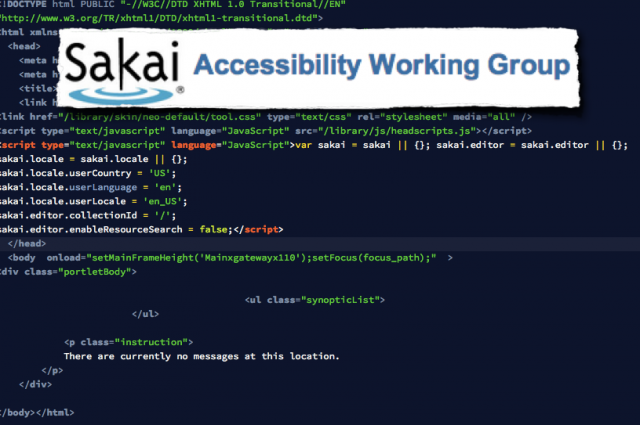Rally of the Tall Pines 2013
Sun Dec 1 23:00:21 2013 EST (-0500 GMT)Rally of the Tall Pines 2013, a set on Flickr.
Some great weather at a great location.
Rally of the Tall Pines 2013, a set on Flickr.
Some great weather at a great location.

At Brock University we use Isaak as our learning management system, which is based on the Sakai CLE.  In Ontario Canada we’re operating under the increasingly more stringent Accessibility for Ontarians with Disabilities Act (AODA) which wisely cites the various levels of the WCAG 2 as its own standards.  Because of this and because its the responsible and technologically ideal way to proceed: web accessibility is important to me.
I’m a big believer that there’s a lot that can be done to improve web accessibility if more people just had a little more knowledge about the issue and the solutions and were able to apply that knowledge at the correct time.
To that end I’m coordinating conference calls about Sakai accessibility every other Thursday at 2:00 eastern (all are welcome – ![]() Add the next meeting directly to your calendar.). Â What we do as an accessibility working group is review general issues and trends in the Sakai CLE (sometimes there’s an OAS), set goals, offer advice, and slog through the JIRA tickets (bugs in the bug tracker) and offer to add a solution, advice or other wisdom as needed. Â We’re also trying to spread critical web accessibility information in the Sakai community and beyond.
Add the next meeting directly to your calendar.). Â What we do as an accessibility working group is review general issues and trends in the Sakai CLE (sometimes there’s an OAS), set goals, offer advice, and slog through the JIRA tickets (bugs in the bug tracker) and offer to add a solution, advice or other wisdom as needed. Â We’re also trying to spread critical web accessibility information in the Sakai community and beyond.
Projects in the Sakai community include ongoing information sharing and canvasing (even, blogging) about the need to get more people involved, and reaching out to other upstream projects, like CKEditor and JQuery UI to both pass feedback to them and to apply their latest and greatest solutions to Sakai.
I don’t claim to be an accessibility expert, but I do understand the standards and I’ve been writing HTML so long I the two platforms I originally had to test on were a 486 Compaq and an Amiga A2000HD. More importantly, I care.
So if you’re at all interested, even if you’re a novice, join the mailing list maybe attend a conference call. Â If you have an interest and a little time, we can transfer you some skill – the working group needs people’s time, skill and a whole lot more, but time more than anything else.
If you’re someone who’s noticed an accessibility issue in Sakai – I want to know. Â This information is valuable to us and we need your help to understand it. Â Comment below or contact me through work or home.
Toronto Indy 2013, a set on Flickr.
Posted on flickr, my photos from the Toronto Indy 2013. The highlight for me was the Stadium Super Trucks taking on the Indy tracks with the addition of jumps!
…sorry about that. Â I used to be so good at making one post a month.
A lot of work has been going into things other than my blog.  Raising two kids takes a lot of work, and so far my wife hasn’t gone for the division of labour of one child each and Dad takes whichever is less work at the time.  The Brock University’s eLearning Initiative continues to be a lot of work.
But mostly, there are so many more [micro] ways to communicate these days.
More to come soon — this is my transition.
At this time of year the interwebs get very productive creating blog postings about productivity, and this blog is all about me adding  information to an existing saturation, so here goes:
These two recent articles have some good ideas for a more productive 2013:
Geeks are always keen to approach organizing their lives as an engineering problem.  Hence the obsession with David Allen’s Getting Things Done is a time-management methodology  and the steady flow of ideas that come out of lifehacker.com
Here’s what I consider my top five most productive practices:
Also, never forget anything! Â For that trick, please see my blog posting on Evernote.